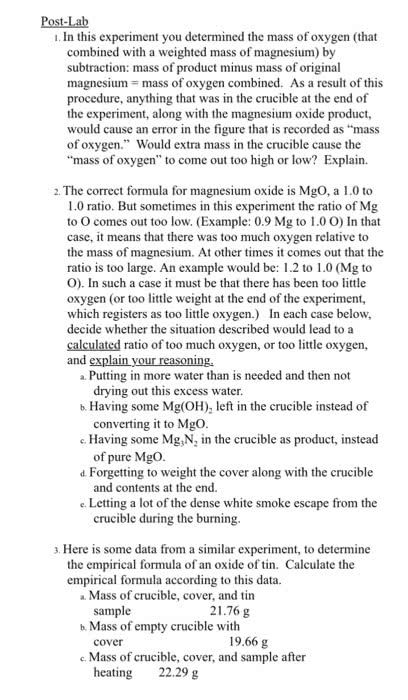When magnesium metal is burned in air (Figure 3.6), two products are produced. One is magnesium oxide, MgO. The other is the product of the reaction of Mg with molecular nitrogen, magnesium nitride. When water is added to magnesium nitride, it reacts to form magnesium oxide and ammonia gas. (a) Based on the charge of the nitride ion (Table 2.5), predict the formula of magnesium nitride. (b) Write a balanced equation for the reaction of magnesium nitride with water. What is the driving force for this reaction? (c) In an experiment, a piece of magnesium ribbon is burned in air in a crucible. The mass of the mixture of MgO and magnesium nitride after burning is 0.470 g. Water is added to the crucible, further reaction occurs, and the crucible is heated to dryness until the final product is 0.486 g of MgO. What was the mass percentage of magnesium nitride in the mixture obtained after the initial burning? (d) Magnesium nitride can also be formed by reaction of the metal with ammonia at high temperature. Write a balanced equation for this reaction. If a 6.3-g Mg ribbon reacts with 2.57 g NH3(g) and the reaction goes to completion, which component is the limiting reactant? What mass of H2(g) is formed in the reaction? (e) The standard enthalpy of formation of solid magnesium nitride is -461.08 kJ/mol. Calculate the standard enthalpy change for the reaction between magnesium metal and ammonia gas.
When magnesium metal is burned in air (Figure 3.6), two products are produced. One is magnesium oxide, MgO. The other is the product of the reaction of Mg with molecular nitrogen, magnesium nitride. When water is added to magnesium nitride, it reacts to form magnesium oxide and ammonia gas. (a) Based on the charge of the nitride ion (Table 2.5), predict the formula of magnesium nitride. (b) Write a balanced equation for the reaction of magnesium nitride with water. What is the driving force for this reaction? (c) In an experiment, a piece of magnesium ribbon is burned in air in a crucible. The mass of the mixture of MgO and magnesium nitride after burning is 0.470 g. Water is added to the crucible, further reaction occurs, and the crucible is heated to dryness until the final product is 0.486 g of MgO. What was the mass percentage of magnesium nitride in the mixture obtained after the initial burning? (d) Magnesium nitride can also be formed by reaction of the metal with ammonia at high temperature. Write a balanced equation for this reaction. If a 6.3-g Mg ribbon reacts with 2.57 g NH3(g) and the reaction goes to completion, which component is the limiting reactant? What mass of H2(g) is formed in the reaction? (e) The standard enthalpy of formation of solid magnesium nitride is -461.08 kJ/mol. Calculate the standard enthalpy change for the reaction between magnesium metal and ammonia gas.


